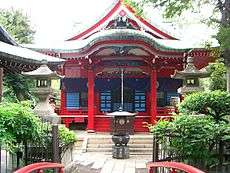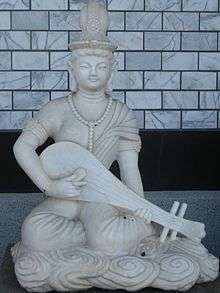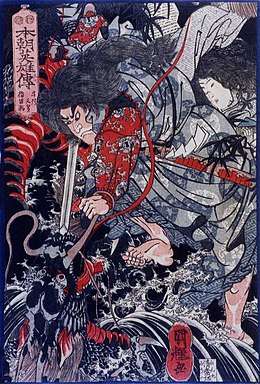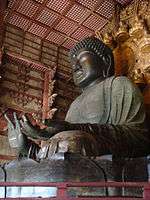Benzaiten
Benzaiten (弁才天, 弁財天) (Benten for short)[1] is a Japanese Buddhist goddess who originated from the Hindu goddess Saraswati.[2] Worship of Benzaiten arrived in Japan during the 6th through 8th centuries, mainly via the Chinese translations of the Sutra of Golden Light, which has a section devoted to her. She is also mentioned in the Lotus Sutra and often depicted holding a biwa, a traditional Japanese lute, just as Saraswati holds a veena. Benzaiten is a syncretic entity with both a Buddhist and a Shinto aspect. Benzaiten was worshiped as the personification of wisdom in the Tokugawa period.[3]
| Sarasvatī (Buddhism) | |
|---|---|
 | |
| Sanskrit | सरस्वती Sarasvatī |
| Burmese | သူရဿတီ Thurathadi |
| Chinese | (Traditional) 辯才天 (Simplified) 辩才天 (Pinyin: Biàncái Tiān) |
| Japanese | (romaji: Benzaiten) |
| Korean | 변재천
(RR: Byeonjae Cheon) |
| Thai | สุรัสวดี (RTGS: Suratsawadi) |
| Tibetan | དབྱངས་ཅན་མ་ Wylie: dbyangs can ma THL: Yangchenma |
| Vietnamese | Biện Tài Thiên |
| Information | |
| Venerated by | Mahāyāna, Vajrayāna |
Transfer from India to Japan

Referred to as Sarasvatî Devî in Sanskrit (meaning "Goddess Saraswati"),[4] Benzaiten is the goddess of everything that flows: water, time, words, speech, eloquence, music and by extension, knowledge.[5] The original characters used to write her name read "Biancaitian" in Chinese and "Bensaiten" in Japanese (辯才天) and reflect her role as the goddess of eloquence. Because the Sutra of Golden Light promised protection of the state, in Japan she became a protector-deity, at first of the state and then of people. Lastly, she became one of the Seven Gods of Fortune (fukujin) when the Sino-Japanese characters used to write her name changed to 弁財天 (Benzaiten), emphasizing her role in bestowing monetary fortune. Sometimes she is called Benten, or Benzaitennyo (弁才天女), where the final tennyo (天女) translates as "goddess".
When Kisshoutennyo is counted among the seven fukujin and fellow fukujin Daikoku is regarded in feminine form, together with Benzaitennyo all three of the Hindu Tridevi are represented in the fukujin.
In the Rig-Veda (6.61.7) Sarasvati is credited with killing the three-headed Vritra also known as Ahi ("snake"). Vritra is also strongly associated with rivers, as is Sarasvati. This is probably one of the sources of Sarasvati/Benzaiten's close association with snakes and dragons in Japan. She is enshrined on numerous locations throughout Japan; for example, the Enoshima Island in Sagami Bay, the Chikubu Island in Lake Biwa and the Itsukushima Island in Seto Inland Sea (Japan's Three Great Benzaiten Shrines); and she and a five-headed dragon are the central figures of the Enoshima Engi, a history of the shrines on Enoshima written by the Japanese Buddhist monk Kōkei (皇慶) in AD 1047. According to Kōkei, Benzaiten is the third daughter of the dragon-king of Munetsuchi (無熱池; literally "lake without heat"), known in Sanskrit as Anavatapta, the lake lying at the center of the world according to an ancient Buddhist cosmological view.
Earlier documents such as those recorded by Buddhist monks link the periodic appearance of comets with the goddess Benzaiten. For example, the comet that appeared in 552 AD, and again in late 593 AD were associated with deity Benzaiten.[7] These records suggest that the exchange of cultural and spiritual ideas from Buddhism and Hinduism in India to Japan, through deities such as Benzaiten, occurred well before the 5th century.
Two qualities of Saraswati that were transposed to the Buddhist version of Benzaiten are music and wisdom. She is sometimes referred to as Myoonten "goddess of wonderful sounds."[8]
Benzaiten as a kami
Benzaiten is a female kami to Shinto with the name Ichikishima-hime-no-mikoto (市杵島姫命).[9] Also, she is believed by Tendai Buddhism to be the essence of kami Ugajin, whose effigy she sometimes carries on her head together with a torii (see photo above).[10] As a consequence, she is sometimes also known as Uga (宇賀) Benzaiten or Uga Benten.[1] Shrine pavilions called either Benten-dō or Benten-sha (弁天社), or even entire Shinto shrines can be dedicated to her, as in the case of Kamakura's Zeniarai Benzaiten Ugafuku Shrine or Nagoya's Kawahara Shrine. Benzaiten, in Japanese mythology, is also one of the Seven Lucky Gods.
See also
| Wikimedia Commons has media related to Benzaiten. |
Notes
- Ludvik, Catherine. “Uga-Benzaiten: The Goddess and the Snake.” Impressions, no. 33, 2012, pp. 94–109. JSTOR, JSTOR, www.jstor.org/stable/42597966.
- Catherine Ludvik (2001), From Sarasvati to Benzaiten, Ph.D. Thesis, University of Toronto, National Library of Canada; PDF Download
- Japanese Journal of Religious Studies. 24-25: 397. 1997. Missing or empty
|title=(help) - Saraswati meets Buddha, SHAILAJA TRIPATHI, The Hindu, March 21, 2016
- Artstor. "Artstor". library.artstor.org. Retrieved 2018-11-26.
- T. Suzuki (1907), The seven gods of bliss, The Open Court, 1907 (7), 2
- Juhl et al, DOCUMENTARY EVIDENCE FOR THE APPARITION OF A COMET IN LATE 593 AND EARLY 594 AD, Lunar and Planetary Science XXXVIII (2007), Antarctic Institute of Canada
- Pye, Michael (2013). Strategies in the study of religions. Volume two, Exploring religions in motion. Boston: De Gruyter. p. 279. ISBN 9781614511915. OCLC 852251932.
- Bocking, Brian (1997). A Popular Dictionary of Shinto - 'Benzaiten'. Routledge. ISBN 978-0-7007-1051-5.
- Itō, Satoshi: "Ugajin". Encyclopedia of Shinto, Kokugakuin University, retrieved on August 15, 2011
Sources
- Japan and Indian Asia by Hajime Nakamura. Publisher: Firma KLM, 1961. Publication Date: 1961
- India and Japan: A Study in interaction during 5th cent - 14th century - By Upendra Thakur



